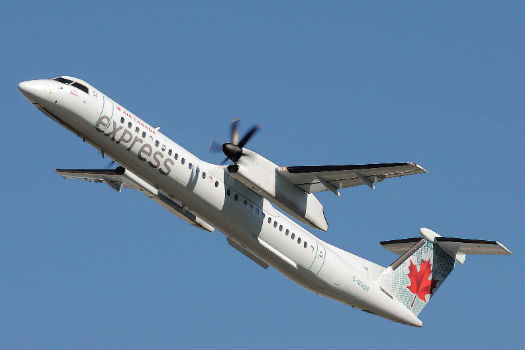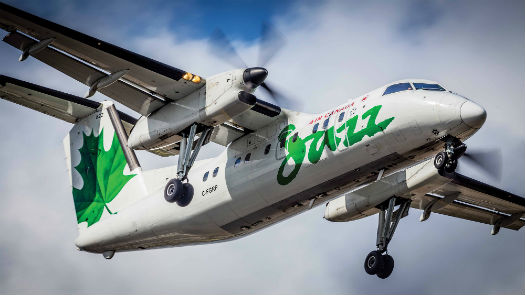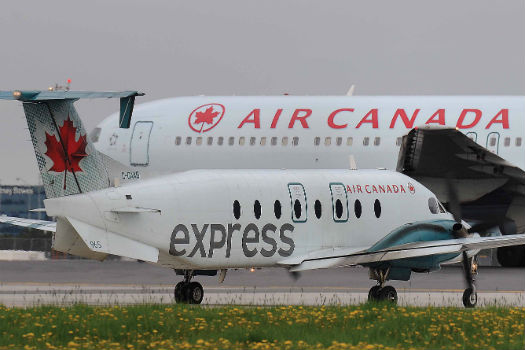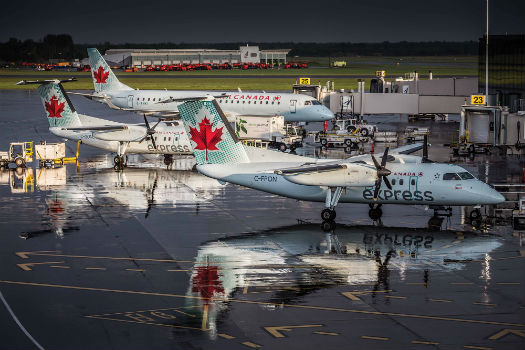The Bombardier CRJ705 is a version of the CRJ900, with seating restricted to 75 seats. It’s used by Jazz to serve long thin routes in Canada and the United States. Galen Burrows Photo
As Air Canada’s bright new fleet of long-haul Boeing 777-300s and 787 Dreamliners take off for new international destinations, many seats in these wide-body jets are filled with passengers who have connected from more than 85 communities in Canada and the United States that are served by Air Canada Express (ACE) carriers.
In 2014, Air Canada reported its best financial performance in its 77-year history, earning adjusted net income of $531 million while transporting 38.5 million passengers–three million more than in 2013.
Last year, about 11 million of these passengers flew on Air Canada Express flights serviced by 164 turboprops and regional jets hired from four independent regional airlines: Jazz Aviation LP (wholly owned by Chorus Aviation Inc.); Air Georgian Ltd.; Exploits Valley Air Service (EVAS); and Sky Regional Airlines Inc.
Collectively, Air Canada paid these regional airlines $1.182 billion in fees to fly the network, plus pass-through costs such as landing fees and fuel. The cost comes in as the national carrier’s third-largest expense after fuel and wages/salaries/benefits for its own employees.
Between 2011 and 2014, Air Canada diversified its regional flying by contracting Sky Regional, Air Georgian and EVAS to fly more aircraft and routes.
Then, in October 2014, Air Canada concluded a new 10-year collective agreement with the 3,000-member Air Canada Pilots Association (ACPA) that included updated pay rates and other contract revisions.
“In addition to labour stability and long term cost certainty, the agreement also provides for increased flexibility with respect to regional airline capacity purchase agreements (CPA) to help ensure cost competitiveness,” noted Air Canada at the time. (Capacity purchase agreements are also known as ”fixed-fee arrangements” or ”contract flying” contracts.)
In February 2015, Air Canada amended and extended its CPA with Jazz Aviation (Chorus)–Canada’s second-largest airline by fleet size–for 11 years, through Dec. 31, 2025.
“This milestone 11-year agreement with Chorus Aviation represents another important step towards sustainable profitable growth,” said Calin Rovinescu, president and CEO of Air Canada.
“The agreement significantly increases our competitiveness in regional markets through lower unit costs and an improved product offering. The resulting stronger network will support our commercial strategy of expanding internationally and increasing connecting traffic through our hubs,” he added.
The amended CPA with Jazz was subject to a number of conditions, including ratification of an 11-year contract with its airline pilots that included a no strike, no lockout provision.
Once the deal was signed, Jazz Aviation announced new orders for Bombardier Q400s, the creation of a new airline to fly its “classic” Dash 8s, and the launch of an extended service program to extend the operational life of its Dash 8-300s by 50 per cent.
Of particular significance, the new CPA includes a pilot mobility agreement (PMA) that will see Air Canada immediately begin hiring 80 per cent of its new pilots initially from Jazz, and later from the family of ACE carriers.
In March, Jazz parent Chorus Aviation announced plans to purchase Voyageur Airways of North Bay, Ont., for $80 million, to diversify its business.
The Bombardier Q400 entered service with Air Canada Express in 2011 at Jazz and Sky Regional. Twenty-six are in service, and Jazz recently ordered 13 78-seaters, with options for 10 more. Eric Dumigan Photo
All that Jazz
In 2000, Air Canada merged with Canadian Airlines. Subsequently, their respective regional airlines–Air BC, Air Ontario, Air Nova and Canadian Regional Airlines–were consolidated to form Air Canada Regional Inc., which later became Air Canada Jazz (Jazz) in 2002.
Air Georgian and Central Mountain Air were also hired to fly Air Canada’s Tier III “Air Alliance” routes to smaller Canadian and U.S. markets, using 18-seat Beech 1900Ds.
When Air Canada filed for bankruptcy under the Companies’ Creditors Arrangement Act (CCAA) in December 2003, Jazz became part of the corporate restructuring.
Post-bankruptcy, Air Canada contracted all of Jazz’s flying through a CPA that helped make the regional airline attractive as a profitable income trust. The terms included a generous 12.5 per cent cost-plus markup for the airline’s controllable costs. This made good business sense in 2006, but it became a growing burden for Air Canada as low cost competition increased.
Air Canada Express
In May 2011, the Air Canada Express brand replaced Air Canada Jazz as part of the mainline carrier’s rebranding of regional services.
The launch coincided with Sky Regional Airlines commencing Bombardier Q400 service between Billy Bishop Toronto City Airport and Montreal, and Jazz commencing Q400 service in June 2011 to replace 50-seat CRJ regional jets on select routes.
When Air Canada and the ACPA failed to reach agreement on a new labour contract in 2012, the airline won in arbitration the right to diversify its regional air service providers and launch a new low cost airline–Air Canada rouge–which would pay lower wages and benefits. This allowed Air Canada to transfer its 15 73-seat Embraer E175 regional jets to Sky Regional in 2013, and begin transferring its Airbus A319s and Boeing 767-300 fleet to rouge, which is a subsidiary of Air Canada Vacations.
Meanwhile, Jazz retired 32 50-seat regional jets over three years and replaced them with 21 74-seat Bombardier Q400s.
Then, in September 2013, Air Canada invited regional airlines to bid to take over some Canada-U.S. trans-border regional flights from Chorus Aviation Inc.’s Jazz, in an effort to further cut costs. Air Canada awarded these routes to Air Georgian in December 2013, which in turn leased six Bombardier CRJs from Calgary’s Avmax Group and commenced jet service in mid-2014.
Air Canada transferred its 15 Embraer E175 regional jets from the mainline carrier to Sky Regional in 2013. Air Canada says this has resulted in an 11 per cent saving in operating costs. Eric Dumigan Photo
Winds of Change
Growing domestic and trans-border airline competition is increasingly challenging the status quo at Air Canada and for Air Canada Express operators.
The most aggressive challenger is WestJet Encore, WestJet’s new regional airline subsidiary, which launched service with high-speed 78-seat Bombardier Q400 Next Gen turboprops in Western Canada on June 24, 2013.
During its first 17 years of service, WestJet operated one aircraft type–the Boeing 737–which had too many seats to profitably serve many Canadian regional markets.
Plans to launch a regional airline moved forward after Gregg Saretsky became WestJet president and CEO in 2010. Previously, Saretsky spent almost a decade at Alaska Airlines, where the Bombardier Q400 made a lot of money for its sister company, Horizon Air.
In August 2012, WestJet Encore announced an order for 20 Bombardier Q400s and 25 options, with deliveries commencing in 2013.
Encore’s expansion playbook included cutting existing fares by up to 50 per cent when it entered a new market to stimulate competition and passenger traffic. In the past two years, Encore claims that this usually results in at least a 40 per cent increase in traffic demand, with about 50 per cent of its new guests connecting to WestJet 737 flights.
Encore’s stated goal is to capture a 40 per cent share of the Canadian regional airline market once it receives its full fleet.
By mid-April 2015, the regional airline was flying 19 Q400s serving 31 destinations from coast to coast, with several new routes scheduled to commence in Atlantic Canada by the summer.
Air Canada’s Regional Strategy
The regional airline market in Canada is a mature business.
“Five years ago, we started diversifying our regional flying from a single supplier,” said Kevin Howlett, Air Canada’s senior vice president, regional markets. Today, it’s a far more competitive environment and we need to be cost-effective to access regional passengers.”
He added that the big focus for Air Canada these days is growing its international services, with the help of additional Boeing 777 and 787 wide-body aircraft departing from hubs such as Toronto, Vancouver, Calgary and Montreal.
“We need to serve these hubs with strong multiple connections from markets across North America. Our regional airlines play an important role in this regard, especially in areas like Atlantic Canada, and throughout the smaller markets in Quebec, Ontario, Western Canada and the United States,” said Howlett. “This supports 6th freedom traffic over our hubs to international destinations.” (Sixth freedom traffic refers to international to international connecting passengers.)
He explained that Canadian domestic market realities favour the Bombardier Q400 aircraft, which can serve both large and small communities. In the U.S., however, the market is more suited to larger regional jets, so Bombardier CRJ705s and Embraer E175s are used on U.S. trans-border routes.
The evolution of “scope clauses” (setting the size and scope of regional airline operations) in North American mainline airline pilot collective agreements has been a catalyst for change, according to Howlett. As the mainline fleet grows, the Air Canada Express fleet can grow proportionately.
There is no cap on the number of turboprops Air Canada Express can fly or the maximum seating; however, the regional jet fleet is capped at 76 seats.
The Jazz fleet will reportedly be split in two. A new, yet to be formed airline will fly the “classic” Dash 8-100 and Dash 8-300 fleet. Jan Jasinski Photo
Jazz Transformation
Jazz considers the new CPA a “win-win” for both companies.
“We have begun a new chapter in the evolution of our airline,” Jazz COO Jolene Mahody told Skies. “The new CPA agreement is much simpler and Jazz will charge a fixed-fee per aircraft, with all our current costs built into the fee per aircraft. We looked at what was happening in the U.S. for guidance.
“Ultimately, the goal was to drive costs down for both parties to retain the passengers we have, better feed the Air Canada network, and attract more business,” she continued.
Jazz serves 72 destinations across Canada and the United States with approximately 800 daily weekday flights, had revenues of $1.7 billion (2014) and carried 9.9 million passengers in 2014. The airline operated 125 aircraft and employed 4,132 people at year end 2014.
Jazz is moving forward with other significant changes, in addition to its simplified cost structure. In early February, the airline announced plans to buy up to 23 new Bombardier Q400 Next Gen turboprops to replace 28 Dash 8-100s and 16 Bombardier CRJ100/200 aircraft over the next 10 years. The firm order of 13 Q400s is worth approximately US$424 million, and could increase to US$758 million should Chorus exercise all of its options.
Transitioning pilot wages is also an important part of lowering the cost structure at Jazz, explained Mahody. “At present, 85 per cent of our pilots are paid at the top wage scale. That’s a pretty significant demographic challenge.”
Beginning in March, Air Canada committed to hiring 80 per cent of its new pilots from the pilot mobility agreement (PMA) list, which contained a minimum of 625 Jazz pilots (with hiring offers made in order of seniority).
Early retirement incentives are also being offered to Jazz pilots who are not interested in transferring to Air Canada. Once the PMA list is exhausted, Air Canada will recruit 80 per cent of its new pilots form the ACE airline family.
“Air Canada is excited about this because it will give us access to a group of highly trained regional airline pilots,” commented Air Canada’s Howlett.
Under the new collective agreement, new hire pilots will receive wages and benefits competitive with WestJet Encore and U.S. regional airlines.
To help further cost reductions, the Jazz fleet will be split in two, with the current airline retaining the Bombardier Q400, CRJ200 and CRJ705 fleet. A new, yet to be formed airline will fly the “classic” Dash 8-100 and Dash 8-300 fleet.
Employees at the “classic” airline will receive lower wages and benefits (similar to Air Canada rouge).
The new CPA also confirms the long-term value of the 50-seat Dash 8-300 to Air Canada Express.
In February, Jazz confirmed it is the launch customer for the Dash 8-300 aircraft Extended Service Program (ESP), which increases the aircraft life by 50 per cent, which is equivalent to about 15 years of flying.
Jazz will begin the ESP program in 2017 and has committed to modifying a minimum of 19 of its 26 Dash 8-300s, with Air Canada providing the financing.
“Our goal is to make Jazz a lower-cost operation so that it will be in a good position to secure additional flying when the opportunity presents itself,” said Mahody.
On the strength of its new contract, Jazz parent Chorus Aviation announced plans in March to buy Voyageur Airways of North Bay, Ont., for about $80 million. The acquisition will enable Chorus to diversify into niche contract flying operations and specialized engineering and maintenance.
Most of Voyageur’s fleet is employed on overseas contracts with “blue chip” international organizations and government agencies. Most of this flying is on an ACMI (aircraft, crew, maintenance and insurance) basis with no exposure to fuel prices, which makes it very similar to CPA flying.
Jazz is gradually retiring its Dash 8-100s from ACE flying, and Voyageur provides a vehicle to put those aircraft back to work. According to Mahody, there are no plans for Voyageur to take over Jazz routes–“They will keep doing what they have done,” she said.
Air Georgian and EVAS fly 18-seat Beech 1900Ds (foreground) on regional routes that feed the Air Canada network. As the mainline fleet grows, the Air Canada Express fleet can grow proportionately. Eric Dumigan Photo
Air Georgian
Air Georgian experienced a growth spurt in 2014 when it started flying six 50-seat Bombardier CRJ100s for Air Canada Express from Toronto to U.S. cities and Charlottetown, P.E.I. The ACE carrier has come a long way since founder James G. Massie started the business in 1985 in Barrie, 100 kilometres north of Toronto.
“A capacity purchase agreement is a predictable business model,” explained Eric Edmondson, president of Air Georgian. “It moves a lot of the variables that occur in a full risk contract (i.e. fuel prices, passenger loads, fares) to the major airline, but the trade-off for a regional airline is lower margins.”
“Under our CPA model, we are compensated on a per-hour basis with a variance for seasonality, base and aircraft type,” he continued. “We are a capital partner with Air Canada, meaning we own our aircraft through a related company, or we lease them from third-party lessors so that we have full asset risk.”
In 2014, Air Georgian flew 500,000 passengers. It employs 155 pilots, 60 AMEs or apprentices, and 115 additional staff. Edmondson said the company is constantly in hiring mode, especially for its Beech 1900 operation, with the pilot attrition rate hovering around 25 per cent for the past few years.
Exploits Valley Air Services
Exploits Valley Air Services Limited (EVAS) is a Tier III Air Canada Express carrier linking 10 Atlantic Canada communities with a fleet of twin-engine, 18-seat Beech 1900D turboprops.
Founded in 1992 by Patrick White as a flight school, EVAS inaugurated Air Canada service between Gander and St. John’s, N.L., in November 2004. The company has expanded steadily.
“The high price of iron ore was stimulating a lot of mining activity in Western Labrador and most of the workers were flying to work on rotating shifts,” explained White, adding that he bought two Beech 1900Ds every time he started a route, taking advantage of low interest rates and a favourable exchange rate.
EVAS is one of the only airlines in Canada to own an international commercial pilot training school, Gander Flight Training (GFT). Its students train to airline standards in miserable Newfoundland weather, which has helped earn them airline jobs flying for EVAS and other operators in Canada and abroad.
White sees the new pilot “flow through” between ACE carriers and Air Canada as an excellent opportunity to connect the dots by establishing an integrated pilot cadet program, which would feed well-trained crews to ACE cockpits, and ultimately Air Canada.
Four Air Canada Express airlines fly 164 regional aircraft, serving more than 85 communities in Canada and the United States. Jan Jasinski Photo
Sky Regional Airlines
Aviation veteran Russell Payson and a senior team of former Skyservice employees created Sky Regional Airlines after winning an Air Canada request for proposals for a low-cost airline to fly new generation 70-seat regional aircraft.
Sky Regional launched Bombardier Q400 service on May 1, 2011, offering daily flights between Billy Bishop Toronto City Airport and Montreal.
In late 2012, Q400 service was extended from Montreal to Moncton; then, in March 2013, Sky Regional started flying the first of 15 73-seat Embraer E175 regional jets, transferred from the mainline fleet.
“We are a very cost conscious airline and pay close attention to all cost areas to stay competitive,” commented Helen Papathanasakis, chief operating officer, Sky Regional, which now employs 500 people supporting 20 aircraft.
Most of the E175 fleet flies trans-border routes to the Northeastern U.S. (i.e. New York, Boston, and Philadelphia) as well as Chicago and Dallas.
Air Canada and the members of the ACE network are continually refining their business models, as the Canadian regional airline landscape grows and changes. The group is facing increased competition from domestic and U.S. airlines–which is the catalyst that recently led to the creation of a leaner, more efficient Air Canada Express network. With WestJet Encore aiming for a 40 per cent share of the regional market, there was simply no other choice.











